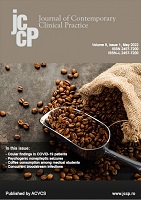A study of semiology and socio-economic factors in patients with psychogenic nonepileptic seizures from a tertiary care hospital in Eastern India
A study of semiology and socio-economic factors in patients with psychogenic nonepileptic seizures from a tertiary care hospital in Eastern India
Author(s): Rajalaxmi Satapathy, Pitamber BehuriaSubject(s): Clinical psychology, Health and medicine and law, Socio-Economic Research
Published by: Asociația pentru Creșterea Vizibilității Cercetării Științifice (ACVCS)
Keywords: nonepileptic seizures; PNES; antiepileptics; hypermotor; hypomotor;
Summary/Abstract: Psychogenic nonepileptic seizures (PNES) is a non-epileptic event which needs to be differentiated from epileptic seizures and poses a diagnostic challenge. It has psychological etiology without any associated abnormal electrical discharges in the brain. We have tried to explain in detail the semiology and socioeconomic factors of patients presenting with the diagnosis of PNES to our hospital so that it will help in early diagnosis and prevent unnecessary antiepileptics use. This is a retrospective study. We have included all patients admitted to the Neurology Department of Kalinga Institute of Medical Sciences (KIMS) during 2020-2021 and discharged with a diagnosis of PNES. Those having associated epileptic events were excluded from the study. All events were categorized as hypermotor, hypomotor and sensory symptoms as per the patient’s presentation as there is no universal classification system for PNES. A total of 50 patients were included in the study. Of them 70% had PNES of hypermotor and 30% of hypomotor type. The mean number of events in the hypomotor group was significantly higher than that in the hypermotor group. The hypomotor variety was found predominantly in females and hypermotor in males. Overall, 10% of the patients had a history of epilepsy in one of the family members. A total of 74% patients had associated anxiety, depression or post-traumatic stress disorder. Hypermotor events were more common than hypomotor events. Hypomotor events were found mostly in females. Most of the patients had pre-existing anxiety, depression, or posttraumatic stress disorder as underlying risk factors.
Journal: Journal of Contemporary Clinical Practice
- Issue Year: 8/2022
- Issue No: 1
- Page Range: 15-18
- Page Count: 4
- Language: English

